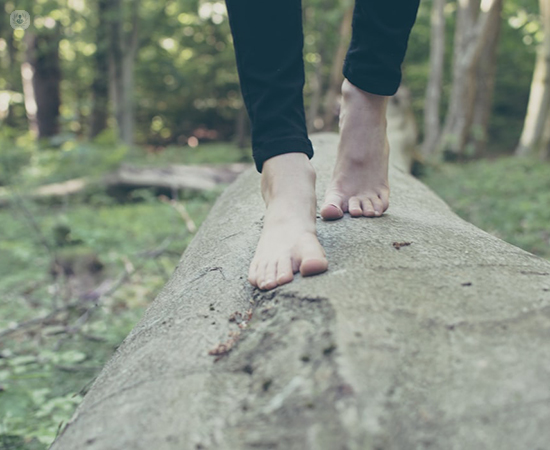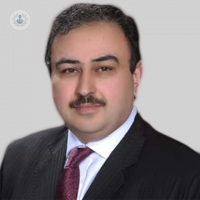Cheilectomy: surgery for big toe arthritis
Written by:Cheilectomy is a surgical procedure carried out to remove excess bone from the top of the big toe joint in patients who suffer from stiffness and pain (hallux rigidus), usually caused by arthritis. The formation of a bone spur can cause a bump on top of the big toe that makes it uncomfortable and painful to wear a shoe and to walk.
Here, one of our expert orthopaedic surgeons Mr Turab Syed tells us all about the cheilectomy, including what happens during the operation and what you can expect during recovery.

How is a cheilectomy done?
During the procedure, a single keyhole incision around 4-6cms long is made on top of your big toe. Once we have cut through the skin, we secure the extensor tendon by moving it out of the way so that we can inspect the joint.
We remove the extra bone by shaving it off using a micro saw that is controlled by either the hand or a foot pedal. It is performed with the utmost precision. We take a little bit extra off from the bone and also remove any damaged cartilage.
If the cartilage has thinned out, we can add microfracture where we make a small drill hole through the subchondral plate, which is a layer of dense bone that supports the cartilage. Blood stem cells will flow from nearby marrow into the joint and make another kind of cartilage, known as fibrocartilage. Fibrocartilage is not as good as the normal cartilage, but it is better than having none at all.
The Nanofracture® is the latest technique for cartilage injury, which only a handful of specialists offer. It is the most advanced technique with special instruments that has better results than with the microfracture.
Finally, we use the saw in reverse to smooth out the bone. The wound is closed with dissolvable sutures and dressing is applied.
Why is the procedure done?
Cheilectomy is performed in order to get rid of the bony lump that is causing pain and discomfort and to allow the big toe to move more so you can, for example, stand on your tiptoes. It is also done to delay a bigger operation on the foot, such as big toe fusing (MTPJ fusion) using plate and screws, joint replacement of the big toe or interposition arthroplasty (Cartiva).
With cheilectomy, we want to get rid of the symptoms and allow the patient to move more but we also want to delay the development of arthritis in the big toe. If we don’t do anything, then further down the line it’s likely that you will need a bigger surgical procedure.
How long does it take to recover from big toe surgery (cheilectomy)?
Recovery is different on every individual, as we all heal differently. In more mature patients, healing slows down. If someone has another medical problem and is taking steroids or having chemotherapy, for example, then healing is going to take longer.
Generally speaking, it takes around two weeks for the wound to heal and around six to eight weeks for the swelling to go down. It is important to keep the leg elevated during the first two weeks otherwise swelling can last up to six months in some cases.
Most people tend to return to full activities including sports at around three months, but the healing rate depends on various factors.
Is it a safe procedure?
Cheilectomy has been around for years and is a gold standard procedure. As with any surgical procedure, there are a small number of risks, such as infection or nerve damage. However, all risks are less than 3-5% in total and it is a reasonably safe surgery.
What aftercare is needed after a cheilectomy?
You really need to follow the postoperative care instructions to heal as well as possible. This includes:
- Wearing a weight-bearing shoe for two weeks to allow the wound to heal.
- Keeping the skin and wound dry. We recommend that you wear a special cover to protect it (or a bin liner) and ensure it does not slip when showering or bathing. Changing the dressings if they get wet.
- Following a range of motion exercises for the big toe, three to five times per day from week two onwards. This is to stop the toe from getting stiff.
- You will also have to massage the scar to desensitise it and reduce swelling.
Even though I am the surgeon, as a patient you are giving me the privilege to help you achieve a better functional result and outcome. Both you the patient and I are equally important in this team and by following the postoperative instructions we can together achieve the best possible results of your final outcome.
Mr Syed is an expert in treating the foot and ankle and if you would like his specialist knowledge in your case, you can book an appointment to see him via his Top Doctor’s profile here.
Mr Syed has been the England Football National Team C and England’s UEFA regions cup squad doctor for almost a decade. He was also the MKDONS football academy doctor and English Cross Country Athletics’ (ECCA) doctor for two years.


